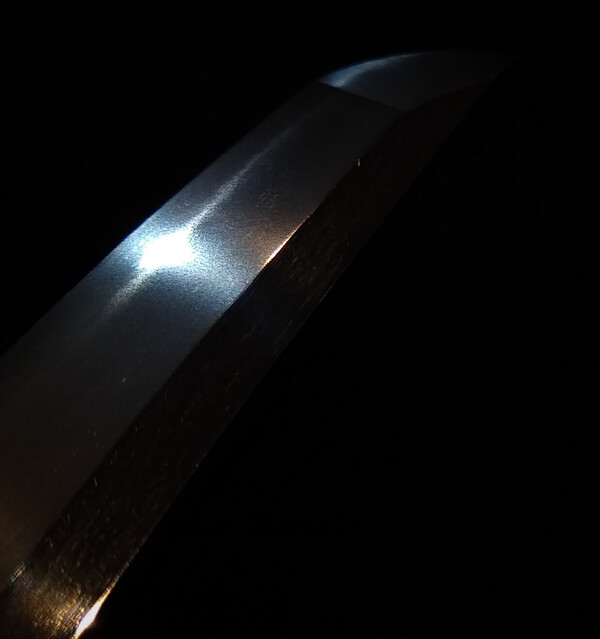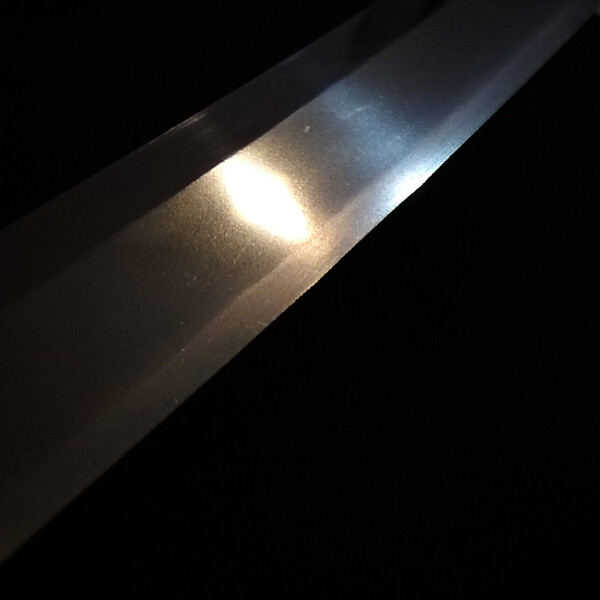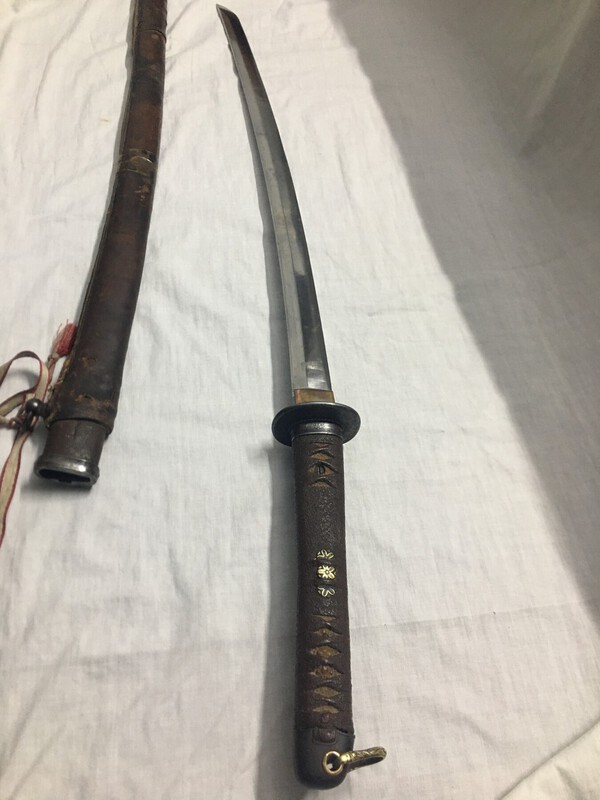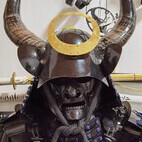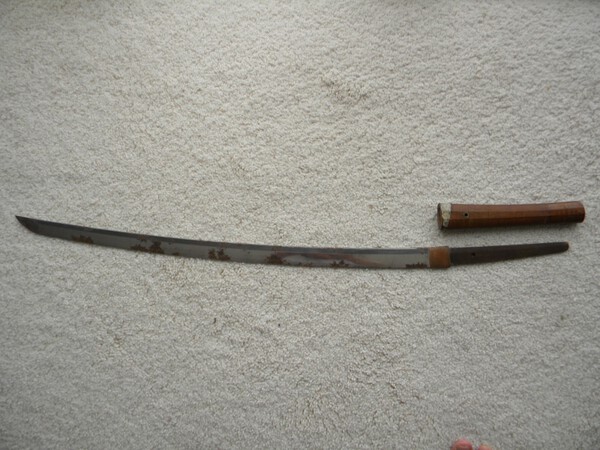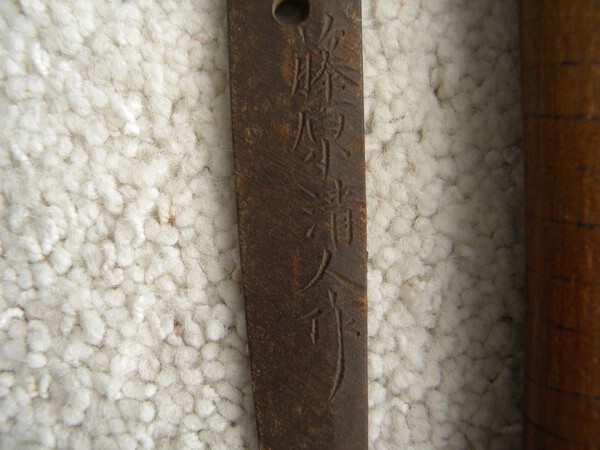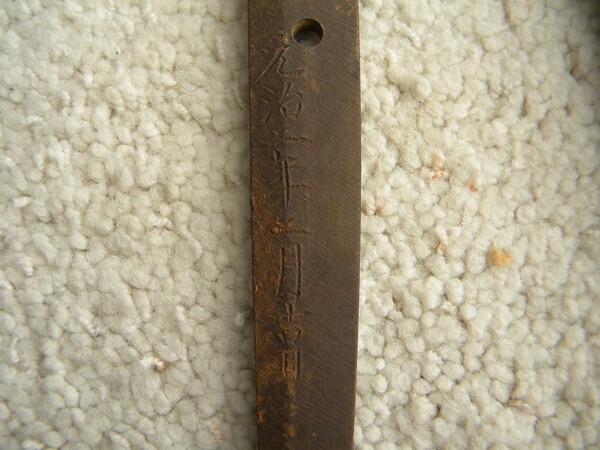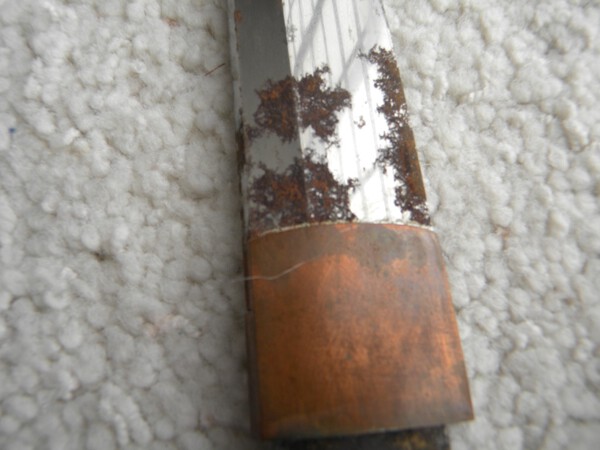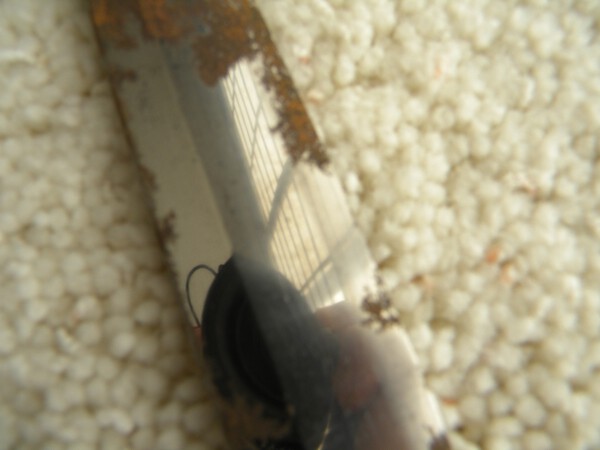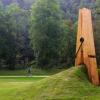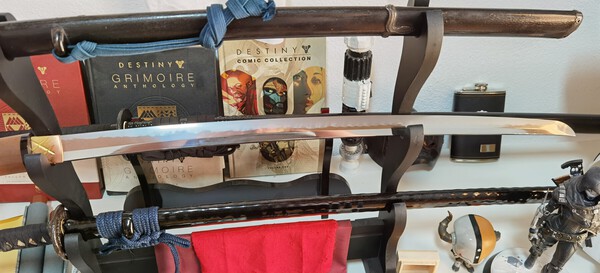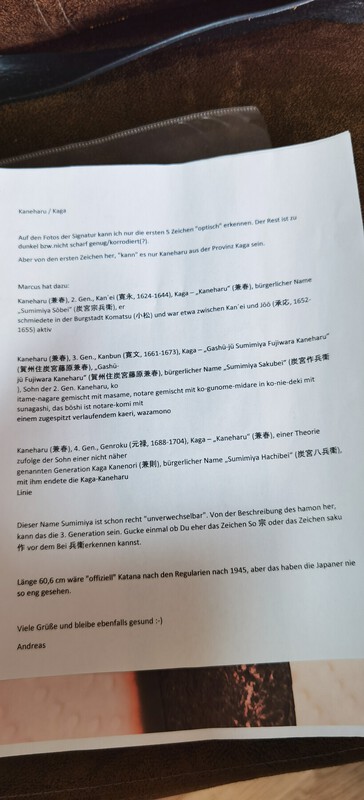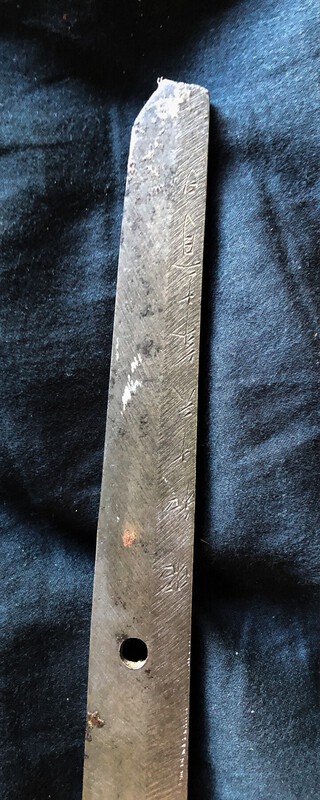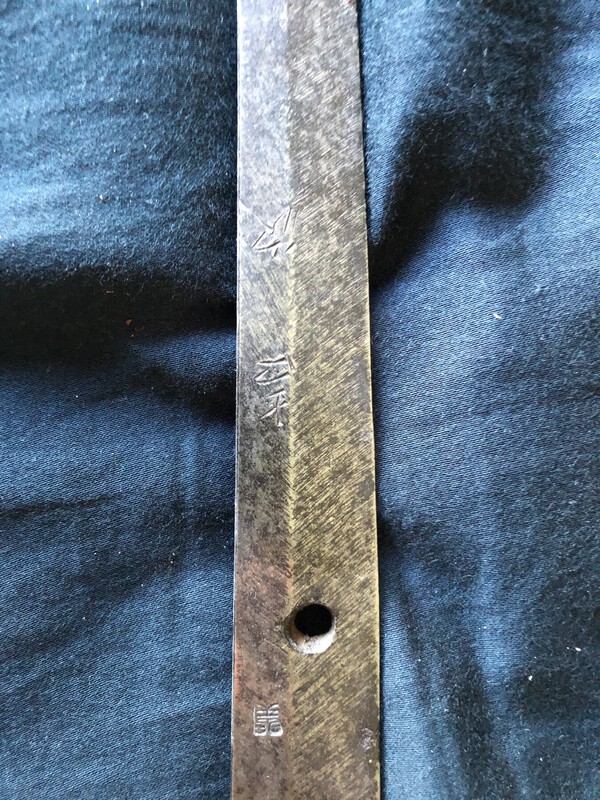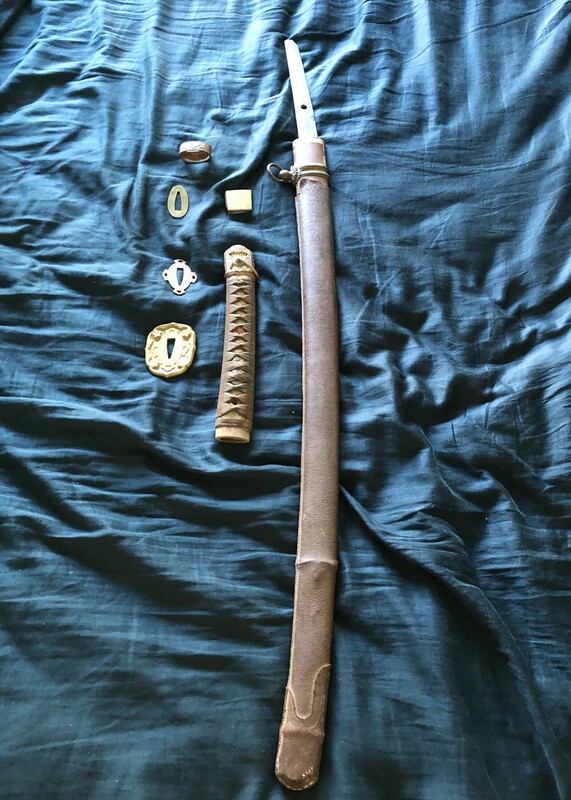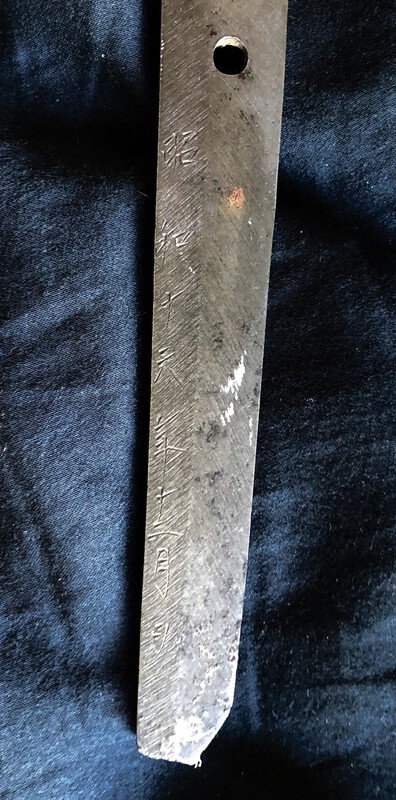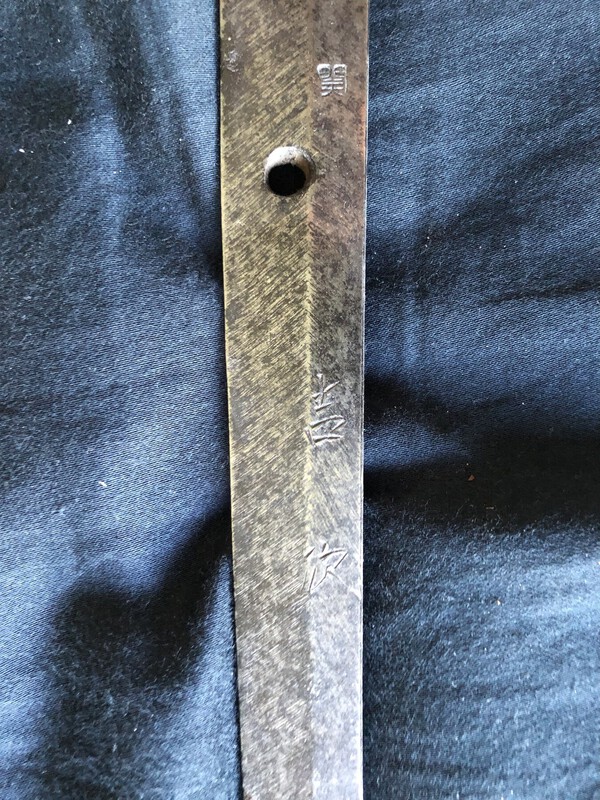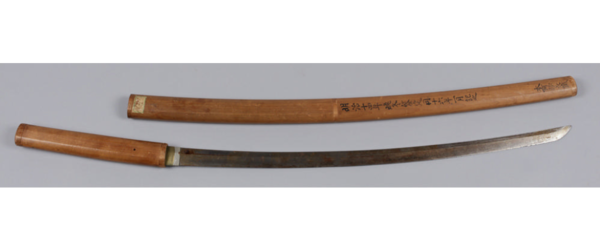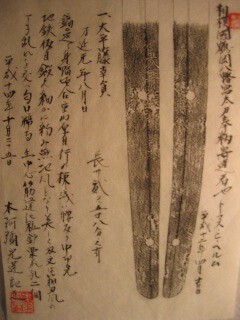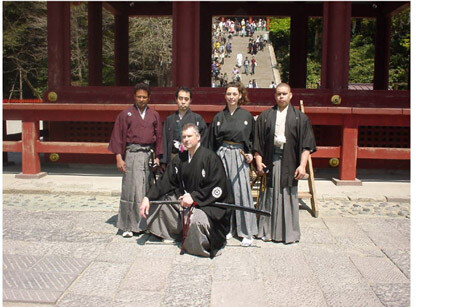Search the Community
Showing results for tags 'katana'.
-
-
Just bought this at a estate auction of a guy who collected militaria. Took a chance and drove 12hrs/800 miles and paid off. Was hoping for NO competition and the locals thought it a common gunto. Anyway, as you can see the blade is dated May 1941 and has to be one of the earliest if not THE earliest sword known forged by Michimasa at the shrine forge. If anyone has seen or knows of a earlier dated blade let me know. Below is the or "my" translation but the family name (Kudo?) may be wrong as am not familiar with this name. Obviously this blade was made for this Haruhito and he probably was a Army Ofc as it comes in Army mounts w/matt rust colored lacquered saya. This is MASATADA's original name and has to be the first or one of the first blades made at the forge. I found a similar shrine sword by Michimasa that rec'd Hozon papers and it is dated July 1941. Neither that sword nor mine have the kikusui on the nakago but kikusui emblem is engraved on both sides of the habaki. Blade is in decent polish with no nicks no problems other than few minor scratches and blems which would easily polish out but I'm too f'n old and not sending this to Japan for polish - too easy to pass it on w/o a new polish. Let me know if a earlier dated blade is known - thanks. hamon is a kind of lazy gunome with profuse nie and short ashi. blade length is 26 1/4 " or 67.7cm tom w OMOTE; 昭和 十六年五月吉日 SHOWA 16 NEN 5 GATSU KICHIJITSU (MAY 1941 AUSPICIOUS DAY) 於 湊川 神社 村上道政作 OITE MINATOGAWA JINJA MURAKAMI MICHIMASA SAKU "MICHIMASA MURAKAMI MADE THIS AT THE MINATOGAWA SHRINE" URA; 謹呈 エ藤 治人博士 御左右 菊水 鍛刀會 KINTEI KUDO?,HARUHITO HAKASE GOSOU KIKUSUI TANTOKAI (PRESENTATION TO THE HONORABLE MR HARUHITO KUDO KIKUSUI ORDERED SWORD FORGING ASSOCIATION ) tsuba , all 6 seppa and fuchi marked; ー目
-
Hey everyone. I ran across this piece today and wanted to get some insight into its authenticity. There was a seki stamp and mei, but I have no ability to translate. They saya was wood and seemed to be a recent replacement. I plan to take a closer look at it tomorrow and could get additional pictures then. Once I got home I noticed I did not have a clear shot of the overall blade. Thanks for sharing your knowledge with me.
-
Hello! I've done my best to translate the writing on the tang of my recently purchased Shin Gunto type 98. For a double check, since this is my 1st time trying to decipher kanji any confirmation would be welcome. It appears there is a SEKI stamp at the top, a kokuin saying Ozawa Kanehisa and I believe the signature to read, Ozawa Kanehisa Saku...but I'm not 100% sure I got everything on that translation. Does anyone have any information on Ozawa Kanehisa? I know this blade is non-traditional but has anyone heard of his style of blade maxing....I assume western steel and oil quenched. If anyone has any insights I would love to hear them. This is for my personal collection and I do not plan on reselling it. Thank you!
- 12 replies
-
- 1
-

-
- manufacture
- gunto
-
(and 1 more)
Tagged with:
-
Katana - Kashu ju fujiwara Nagatsuna 63.9 cm Kanbun jidai Kinzogan mei : Kago tsubei or a woven basket meaning water can't be held or cuts like flowing water. It could be a name or expression. It is sometimes used for swords used for Tameshigiri that cut well. Sayagaki by Sato Kanzan
-
I also have pics of writing on the Tsukamaki. Any assistance in identifying these images would be appreciated!
-
Yeah, don't buy swords online when you are drunk. After losing out on an auction recently, I got all butt hurt about it and went and impulse bought something. Don't get me wrong...I LOVE this sword, but I don't feel like I did enough research before pulling the trigger and now I am struggling to find a comparable signature. I "mei" have made a huge mistake. Here's the thing- I can find a pretty good amount of info on the Ishido school, and Yasuhiro, but I cant find any nakago/oshigata images with this particular signature or with the "ichi" character. When I was in school (Fine Arts Major), students were instructed to make direct copies, and original work "in the style of" old masters. We were instructed to sign this work "after" - so a signature would read "JT Nesbitt, After El Greco". Is the Mei on this blade a similar philosophy? Is Yasuhiro paying homage to Ichimonji in writing? This sword is longer than most Ishido work, 29", and does not have a chrysanthemum, does this mean that it is an earlier (Yasuhiro 1st) Edo period? It's not too late for me to cancel this purchase if the consensus is that I got ahold of a bogue here....Thanks Ya'll for giving me your time!! -- JT
-
Hello all, acquired a few pieces over the past year's mix of COVID lock-downs and while eagerly waiting for the latest to arrive thought I would start a few threads to share the blades with fellow members and provide some more searchable examples of these smiths for the NMB. Also maybe start some discussion if anyone sees anything interesting. The first is a papered NBTHK TH to Ko-Mihara with a sayagaki from Tanobe Sensei. Photos are courtesy of @Ray Singer and will get an in-hand update/photos once it arrives hopefully this week… delayed due to an issue at the DPO transit point . Without a full translation yet but looks like Tanobe-sensei commented that it a representative example of the sword, dates to Nanbokucho jidai, is osuriage mumei, and yuhin (exceptional work). I had been on the lookout for a blade in this style with some helpful advice and comments on other pieces from @paulb . nagasa: 66.3cm moto-haba: 28mm saki-haba: 18mm kasane: 6.5mm The next two pieces to be posted await post-COVID shinsa but have other attributions that might spur some debate.
-
What do you do with the leather field scabbard that’s falling apart due to old age ?
-
Afternoon/morning gentlemen! Its been a while since I've posted a blade of mine here but I just recently bought this from Eric from his eBay store for a modest sum. I rather like the blade despite the few flaws it has. I will let the pictures do the talking since Eric was so kind as to allow me to keep/use them here for discussion. Eric believes it is Sue-Bizen and dates to around 1530. Utsuri is present. Here are the measurements and specifics, as per Eric: Blade: Nagasa: 25" Nakago : 5-5/8" Total blade length : 30-5/8" Blade thickness at the habaki notch : 7.13 mm Width at the habaki : 1-3/16" Width at yokote level : 13/16" Sori / curve : 7/16" Point / Kissaki : 1-1/4" Hamon: A beautiful very attractive well controlled Choji-ba on both sides. Strong long point/kissaki & there is boshi turn-back on both sides. Hada : Itame mix with beautiful activities within Mounts: Blade rests in its original WW2 gunto mounts circa 1940 in fair condition Showing some wear & tear from age & WW2 use. A Family Mon on Kashira & wooden scabbard with no leather cover. Pieced Tsuba + 4 seppa's Original old silver foil habaki Solid handle but showing some fraying & losses on the brown-silk wrap Good solid scabbard & the lock mechanism works fine. My only ask is: what do you all think of it? I think I did pretty well. I am happy with it and there is a lot to study.
-
Hi there, Its me again. This time I wanted to post my 2 katana that i own. both of them seem interesting, atleast to me. The one in koshirae couldnt be attributed to a smith(in the hozon certificate), the only information i have about it is that its mumei, sue bizen school and from the bunmei era (1469 - 1487). it also has a bit of damage at a specific spot (shown in the pictures). If anyone is able to find out more info about it, please tell me. The one in the Shirasaya is allegedly a Kaneharu Gen.3 piece (Kanbun 1661 - 1673). it isnt NBTHK papered but i have Japanese registration papers and an assessment document of an expert from germany. what i find interesting about it is that its length is 2 shaku down to the millimetre. so from the length alone it could be both a katana or a wakizashi. Now i first gotta save some money till i can make my next purchase.
-
My Nisei dad and mom received this gift from her father when they were married in Japan after WW2. My grandfather was sensei and had his own kendo dojo. We lived in Japan for 2 years in the early 1960’s when my dad was stationed in Korea with the 25th infantry division. I was in junior high school at that time. We visited my grandfather during the summers and he came to visit us in Tokyo several times. The katana was kept at my uncle’s home in Hawaii down in their garage. What you see in the pictures is it’s condition after my dad retrieved it in the 1980’s. Termites destroyed the wood Saya and the Tsuka is what’s left. My mom is now 92 and we are thinking about what to do with the katana. I think we would like to try and bring it back to the condition it was; when it was gifted. We would like to find out how to do this and what it would cost. I believe we will keep the legacy in the family. Comments and any other thoughts would be appreciated. I am not well informed on these matters. We have two other katana. One that my dad won in a kendo tournament in Hawaii when he was in high school. Another that my dad brought back from the Philippines. He was stationed there in MIS under General MacArthur during WW2. These are still in excellent condition as they were always kept here. Thanks. - RayM
-
Sorry to post things that may be fake (rather than good stuff) but it makes me really angry when I see sellers describing swords that, some would consider, not genuine. Noticed this sword at.... https://www.ebay.com/itm/384240327437 Now I am far from an expert (no, REALLY far), but there are a number of things I see in this sword that, in my mind, don't equal "antique" "Origin Japan" 'WW2 1939-45' etc. The seller has 100% feedback so that makes me cautious. I have been wrong many times in the past, most recently with a fake 95 (looked genuine 🤔 but clearly accept the concensus ). So do you think its a rip-off low down fraudelent listing or a genuine gunto in all respects? Rob PS ...I have absolutely no desire to purchase it.
-
Posted across several threads due to size limits....please see my profile for the rest.... As promised I'm sharing an overview of our small collection of nihonto. We're a small volunteer run museum in NZ. We don't know a ton about this collection and due to many factors much of the paperwork is missing, so we don't know the stories around how they came to be in the museum. At some time in the past the blades were all liberally coated in oil, we think maybe linseed oil. We've gently cleaned it off but as you can see it has stained the blades. They are all very much out of polish, which makes it very hard to see the hamon. We've done our best with the photos, to show the elements which would be useful in terms of ID. Full care for all of these nihonto is unfortunately outside the parameters of our current project, both time wise and budget wise. However, if the community on here identifies anything particularly special, we might be able to organise some special treatment. I hope this doesn't sound harsh. It's just that we are cataloguing and caring for an entire museum on a tiny budget. We really love these nihonto which is why we're sharing them here. So, any ID help is greatly appreciated, or just any general info or discussion at all. Every little bit of knowledge helps. Many thanks friends :-) Catalogue number 2379, previously discussed mismatched saya and blade:
- 10 replies
-
Posted across several threads due to size limits....please see my profile for the rest.... As promised I'm sharing an overview of our small collection of nihonto. We're a small volunteer run museum in NZ. We don't know a ton about this collection and due to many factors much of the paperwork is missing, so we don't know the stories around how they came to be in the museum. At some time in the past the blades were all liberally coated in oil, we think maybe linseed oil. We've gently cleaned it off but as you can see it has stained the blades. They are all very much out of polish, which makes it very hard to see the hamon. We've done our best with the photos, to show the elements which would be useful in terms of ID. Full care for all of these nihonto is unfortunately outside the parameters of our current project, both time wise and budget wise. However, if the community on here identifies anything particularly special, we might be able to organise some special treatment. I hope this doesn't sound harsh. It's just that we are cataloguing and caring for an entire museum on a tiny budget. We really love these nihonto which is why we're sharing them here. So, any ID help is greatly appreciated, or just any general info or discussion at all. Every little bit of knowledge helps. Many thanks friends :-)
- 22 replies
-
- 2
-

-
- restoration
- wakizashi
-
(and 1 more)
Tagged with:
-
I ve gotten into nihonto collecting a couple months ago. my first piece was a wakizashi, a while later i got a Sue Bizen Katana. both of them had Hozon papers. recently i bought a non NBTHK papered Katana/Wakizashi (its 2 mm short of 2 shaku) which supposedly is a kaneharu 3rd generation piece. it had Japanese registration papers (or atleast a copy of them) and apparently some experts in germany had a look over it. since i am fairly new to the game i am not sure who those people are since they only wrote their first names onto the letter of appraisal (Andreas and Marcus). does anybody here know about an Andreas and Marcus from germany who work with nihonto?
-
katana No idea about the sword I have
Dave Harro Harrison posted a topic in Military Swords of Japan
Hi Guys can anyone translate what is on this sword. I believe it is WW2 with a seki stamp and was machine made. Other than this I have no clue. Please help thank you -
Hey everyone, I'm working at a small museum in New Zealand where we have a collection of Japanese swords. I'm currently cataloguing a katana in its wooden saya that has kanji I'm hoping to get translated; the maker, date and location of manufacture, the class of blade if possible, and any other details noted. We've had some rough translations done by a Japanese local so we've been working off those thus far. I think we've narrowed down the appraisal to the Honami family during the Meiji period (1881 or 1883?) but I can't quite pinpoint which member specifically, possibly Chou Shoku or Kochu? We believe it was sold for 150 pieces of gold and the blade length is around 70.902cm. We also think the maker might have been born in Okayama, possibly the western region, within the Kamakura era (1192-1336), with the manufacture date around the late 1240s? These names came up in the translations but I haven't been able to ascertain who or what they are and how they fit into the blade's history: Kaneyasu Tamefusa Norifusa (this is written on the sticker presumably added by past museum staff) Katayama Norifusa Katayama ichimonji Any help translating/reading the kanji would be appreciated, thank you! Sarah
- 16 replies
-
Help translating katana kanji needed (for another set!)
Eve posted a topic in Translation Assistance
Hi everyone, I have another katana and saya with kanji I need translated... I'm pretty sure the saya says 'Kanefusa' but I can't work out the two on the pommel. Any help appreciated! Sarah -
Dear All I have a katana that I am trying to translate all of the kanji. It is tachi mei and on the tachi-omote side it has 肥前国住吉次 Hizen Kuni ju Yoshitsugu This seems to be a Hizen smith from the early 1600’s. On the tachi-ura side there are about 36 kanji. Looks to be from the WWII period. Here is what I have so far and at the Chicago show I had some help that is also listed. Any help in finding the correct kanji and translation would be great. Right Hand Side 大 東 亜 戦 争Daitō Sensō (The Greater East Asia War) ?bo 発hotsu, hatsu, patsu ?shin 春haru, syun 入nyū, ju 営ei ?sai space ?sa 賀ga 大tai, dai, oO ?逋ho, ura Left Hand Side ? ? ? ? min民 誠sei 心shin、 ? i ?san, 百hyaku, momo, byaku 八hachi (8) ?ju 余yo 円tan, en ?uku ru 之kore, shi, no space 菖Shō 菖蒲ayame, bu 道michi 三sa ?Bu ro Thanks david from Montana
-
-
A Gift to Hachiman・or how NOT to conserve a sword “TSURUGAOKA HACHIMANGU ; Famous temple located at Kamakura, dedicated to the god of war-in 1103 Minamoto Yoriyoshi had erected a temple on Yui-ga-Hama, dedicated to Hachiman, the titular god of his family. Yoritomo transported it (1193) to Kamakura and erected it on the Tsurugaoka hill, where it may be seen to the present day. In 1219 the Shogun Sanetomo went there in great pomp to render thanks for his nomination to the dignity of udaijin. After the ceremony, on descending the steps, his nephew, Kugyo, assassinated him. In 1526 Satomi Yoshihiro, the governor of the province Awa plundered the treasures of the temple but Hojo Ujitsuna obliged him to retreat.- The temple of Tsurugaoka is one of the last remnants of the grandeur of Kamakura. Interesting souvenirs of the middle ages are kept in it.” - E. Papinot The layout of Kamakura today is dominated by Wakamiya Oji, the main street in town, which runs dead straight from the beach to the Tsurugaoka Hachimangu Shrine. It was built by the order of Yoritomo, when the Tsurugaoka Hachiman shrine was erected. Moto Hachiman, or the former Hachiman is not far from my house near Zaimokuza beach. There are three Torii that stand over the road to the shrine from Ni no Torii to Ichi no Torii, which stands at the entrance to the shrine grounds; there is a raised path, which is contained within sloping stone walls like a castle. There are cherry trees set all along this path: the Dankazura. It actually tapers down to about a half its width at the shrine end, but due to an engineered optical illusion, it does not appear so. It seems Yoritomo built everything in the town with an eye to warfare; an invading army might charge down this welcoming path four or five across only to find themselves fighting in space wide enough for only two or three. April is the time to don your kimono and stroll the Dankazura enjoying the cherries in bloom. Yoritomo built the Tsurugaoka Hachimangu in fulfillment of a promise he made at the Moto-Hachiman, “should I be successful in my campaign against the Taira, I will build the biggest Hachiman shrine Japan has ever seen right here in Kamakura”. As we all know, the first Shogun’s prayers were answered, and thereafter many people high and low made offerings in thanks for the favors bestowed upon them by the spirits of this beautiful place. For some four hundred years, the storehouse of the shrine collected treasure until in 1526, during the13th battle of Kamakura,・the aforementioned Satomi Yoshihiro caused the destruction of the temple. What wonderful things were lost, we might never know, but there are as yet interesting souvenirs of the middle ages kept here. Kobizen Masatsune tachi, Kokuho Bizen Nagamitsu tachi, Juyo Bunkazai Kuniyoshi tachi, Juyo Bunkazai Soshu Tsunahiro tachi, Kanagawa ken Juyo Bunkazai Tsunaie tachi, Kanagawa ken Juyo Bunkazai Hirokuni tachi, Kanagawa ken Juyo Bunkazai Kunimura, Senjuin, Chikuzen Nobukuni, and Muramasa, all number among the one hundred or so swords that are still in the storehouse of Hachimangu. Hojo Ujitsuna, the 8th, 9th, and 10th Tokugawa Shoguns and the Meiji Emperor are some of the more notable persons making offerings here. It is the ultimate in presumption to consider myself among their number, but the fact remains that late last year I, too determined to present a sword to the shrine. Last year, I retired my Iai-to and though I felt it didn’t need a polish, I decided to do my bit for the Japanese economy and have it polished and put it in a fresh shirasaya. Unfortunately, as sometimes happens, the kawagane proved too thin and the shingane was exposed during polish, to be expected perhaps with a Kamakura period tachi but the mark of death for a shinshinto blade which mine happened to be. I now had a considerable investment in a sword which had cost me too much already and there was certainly no way for me to recover any of the money spent. I resolved therefore to lovingly preserve it as it had near been a very part of my body daily for close to ten years. In the event of my passing on, on some long distant future day, it could be treasured in my family as an heirloom. Reflecting upon the loose hold my family now has on reality and the sheer lack of interest in things Japanese they exhibit, I began to have my doubts about future generations the more I thought about it. How then to conserve this blade in a way I could be reasonably assured it would not be mistreated in the future. As you must have guessed, I hit upon the brilliant idea of donating the sword to the Hachiman shrine. Owing to the poor condition of the blade, I felt it would surely be rejected by the priests. To my surprise Hon’Ami Koji Sensei, my iai teacher, a sword polisher and conservator of the Hachiman shrine sword collection was delighted with my idea. In fact he sat down and immediately started working on a schedule for the presentation. April, 2001 was determined to be the best time so we set things in motion to carry out our Ho-no-shiki or offertory ceremony. What sword you ask is worth all this. It is not at all special, I assure you. Signed OHIRA TO YUKISADA, Dated MANEN GANNEN HACHIGATSU HI. It is a 2 shaku 5 sun 8 bu katana with chu kissaki, shallow koshizori, tight tight itame hada and a rather wide choji midare hamon. The nakago is 27cm long with kurijiri and kattesagari yasurime with kesho yasuri. The gojimei is located in the shinogiji, midway between the mekugi-ana and the habaki moto. There are 2 mekugi-ana, one of which is a shinobi-ana, which was a popular addition in the Bakumatsu era. Ohira Yukisada or Yukikazu is listed as a Musashi area smith who worked around the time of the Meiji restoration or a little before. He styled himself Yu no shin・or bird of progress・ The To (藤) in the signature is also read Fuji・as in Fujiwara so this is an abbreviation. The year 1860, Manen gannen, started out with the assassination of the great elder II Naosuke, by a group of Mito ronin, angered by his policies of placating the foreign powers and punishing those who opposed him including the lord of Mito. The country was taking sides for a battle many were certain was soon to come, one has to wonder which side of the conflict this blade was destined for. This sword was originally purchased at the Great Western Gun Show, at the San Francisco Cow Palace sometime before 1983 for $700. At that time it was in shirasaya with late Edo/Meiji period copper habaki, iron tsuba, iron fuchikashira, a blue linen wrapped tsuka with white same and menuki which had been stripped by the owner prior to me. I bought it in 1987 in this condition. There is perhaps some justice in this sword finding peace back in Japan after the abuse it suffered in America. I immediately sanded down the shirasaya and painted it with green auto-lacquer. Then began the years of swinging, whacking and cutting. Over time I had a new saya made and rebuilt and rewrapped the handle. Now it has a new silver habaki, shirasaya and proper Japanese polish. On a gorgeous Saturday in April some thirty members of the Kamakura Iaido Kyokai and guests gathered at the Hachimangu Shrine. Dressed in formal montsuki and hakama We collected in the maeden, on the same stage that Shizuka Gozen stood upon as she plead for Yoshitsune’s life in song. We bowed before the priest where receiving his blessing we presented for all the gods and buddhas to see, the faithful sword which had seen me through three thousand days of determined practice. Following this, myself and two others had their new swords blessed in a ceremony known as Nyu-kon-shiki and here upon the stage practiced for the first time with those swords. The swords used in the ceremony to be invested with the true spirit of a samurai sword were tied with mizuhiki cord, after each was blessed an attendant handed the swords to Hon’Ami Sensei who then drew his Umetada Myoju tanto and cut the cord. After which each of us presented five kata or forms to the gods of the shrine. As I took the stage to perform my forms, in each corner sat a friend acting as guard against evil, the Shitenno. In the Northeast sat Iwamura Nobuhiro, who some of you have met, 6th dan Muso Jiki Den Eishin Ryu. To the Southeast from Brazil; Candido Roberto Nunez Sequiera, 3rd dan Toyama Ryu Batto-jutsu. To the Northwest from Sri Lanka, Siri Herath, 2nd dan Toyama Ryu Batto-jutsu and in the Southwest from France, Evelyne Sentenac, Shodan Muso Shinden Ryu. Thus all the parts of the globe were represented as I drew my sword and symbolically cut down evil with my newly christened blade. Following the ceremony there was a luncheon, where I was presented with a certificate acknowledging my gift and where I was asked to give a little speech. I thanked everyone and expressed my hope that the sword would reside within the shrine as a symbol of amity between San Francisco and Kamakura, between the U.S. and Japan and persons everywhere. So now this vet pick-up old beater iaito with Mike Virgadamo saya, Russ Axt handle and wrap, Fred Lohmen menuki, Cary Condell oshigata and lacquer job by yours truly, will join the other swords in the treasure house of the great Tsurugaoka Hachimangu where it will be lovingly cared for, for perhaps another 800 years carrying with it a tale of woe all too many swords know today, along with my sincere thanks for the life changing lessons it taught me during our brief journey together and of course the dear friends it has brought me to. @Kamakura in Japan, Thomas C Helm
- 7 replies
-
- 6
-

-

-
- katana
- restoration
-
(and 1 more)
Tagged with:
-
Greetings, I think this Type 3 is a Kinoshita Yoshitada made Katana. Traditional made? Is it San Mai? Worth polishing? Ito in very good condition. Possible value? I have more pix but to many k at one time.


.thumb.jpg.66a44353764ffdc227acb9c3d6347e46.jpg)
(1).thumb.jpg.c3f2ff45254c75af6c1fdd694af3b84a.jpg)











